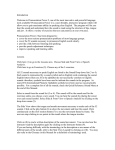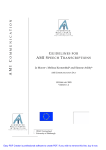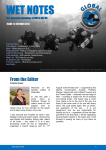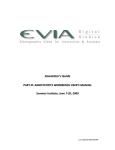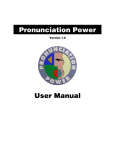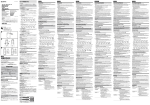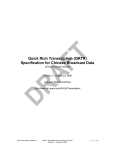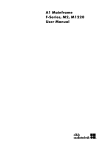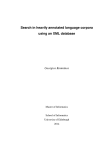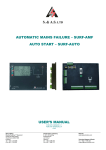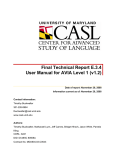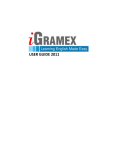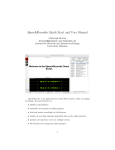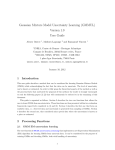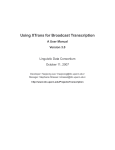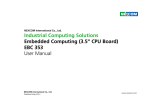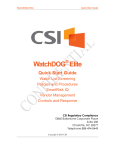Download (QRTR) Specification for Arabic Broadcast Data
Transcript
Quick Rich Transcription (QRTR)
Specification for Arabic Broadcast Data
(XTrans-Format Version)
Version 2 – August 30, 2006
Linguistic Data Consortium
http://www.ldc.upenn.edu/GALE/Transcription
LDC Transcription Guidelines
QRTR - Broadcast Arabic (XTrans Format)
Version 2 – August 30, 2006
page 1 of 19
1
2
3
4
5
6
7
Introduction and Overview .............................................................................3
Data ...............................................................................................................3
Segmentation Task........................................................................................4
3.1
Introduction.............................................................................................4
3.2
Timestamping the Audio .........................................................................4
3.3
What to Segment....................................................................................5
3.4
Segmenting Overlapping and Simultaneous Speech .............................5
Sentence Units (SU) ......................................................................................6
4.1.1
Statement SUs ................................................................................6
4.1.2
Question SUs ..................................................................................7
4.1.3
Incomplete SUs ...............................................................................8
4.1.4
Recognizing SU Boundaries............................................................9
Identifying Section Boundaries ....................................................................10
Speaker Identification ..................................................................................11
6.1
Speaker Type .......................................................................................11
6.2
Names and Identifiers...........................................................................11
6.3
Native and Non-native Speakers ..........................................................12
Transcription ................................................................................................12
7.1
Orthography and Spelling .....................................................................13
7.1.1
Spelling..........................................................................................13
7.1.2
Punctuation ...................................................................................13
7.1.3
Numbers........................................................................................13
7.1.4
Proper Nouns ................................................................................13
7.1.5
Contractions ..................................................................................13
7.1.6
Acronyms ......................................................................................14
7.1.7
Spoken Letters ..............................................................................14
7.2
Disfluent Speech ..................................................................................14
7.2.1
Filled Pauses and Hesitation Sounds ............................................14
7.2.2
Partial Words .................................................................................15
7.2.3
Mispronounced Words...................................................................15
7.2.4
Idiosyncratic Words .......................................................................15
7.3
Speaker Errors and Non-standard Usage.............................................15
7.4
Foreign Languages and Dialects ..........................................................15
7.4.1
Foreign Languages........................................................................15
7.4.2
Dialects..........................................................................................16
7.5
Background and Speaker Noise ...........................................................17
7.6
Hard-to-understand Regions ................................................................17
7.7
Final Pointers........................................................................................18
Appendix 1: Recommended Strategy .................................................................19
LDC Transcription Guidelines
QRTR - Broadcast Arabic (XTrans Format)
Version 2 – August 30, 2006
page 2 of 19
1 Introduction and Overview
The goal of quick rich transcription (QRTR) for broadcast news and broadcast
conversation is to produce a verbatim, time-aligned transcript with minimal but
useful markup. QRTR also identifies some salient structural features of the
broadcast and provides speaker identification.
The elements of a quick rich transcript include:
• verbatim transcription
• time-aligned section boundaries, speaker turns and sentences (segmentation)
• section and sentence type identification
• speaker identification
• standard treatment of common spoken phenomena
Transcription begins with audio segmentation. This involves "timestamping"
structural boundaries including sections (i.e., story transitions), speaker turns and
sentence units (SUs). Speakers are identified by name where possible, or by a
unique identifier, and other speaker traits like sex are noted. Once audio has
been virtually segmented into smaller units, annotators transcribe the content of
each segment. Special conventions are used to flag certain speech phenomena
like disfluencies and mispronounced words. Quality control checks verify the
completeness and accuracy of segmentation and transcription.
QRTR differs from Quick Transcription (QTR) in that each sentence unit is
timestamped and labeled for its type. QRTR differs from careful transcription
(CTR) in the amount of detail contained in the transcript markup, the number of
features identified, the degree of accuracy and completeness of the transcript,
the amount of time taken to complete the file, and the number of quality checks
that are performed on the finished product.
Please see LDC's transcription website for links to guidelines for the various
transcription tasks: http://www.ldc.upenn.edu/Projects/Transcription
2 Data
These guidelines pertain to data in the following genres:
• Broadcast News (BN) consisting of "talking head"-style news broadcasts
from radio and/or television networks.
• Broadcast Conversation (BC) consisting of talk shows, interviews,
roundtable discussions and other interactive-style broadcasts from radio and/or
television networks.
Data is divided into files, which typically correspond to a recording of one
broadcast from a single program. Files are typically 30 to 60 minutes in duration,
though they may be of any length. Files come from a range of radio, television,
satellite and web broadcast sources from around the world. Each show is preLDC Transcription Guidelines
QRTR - Broadcast Arabic (XTrans Format)
Version 2 – August 30, 2006
page 3 of 19
designated as BN or BC based on its characteristic content. Note however that
BN shows can sometimes contain stories that are conversational, while BC
shows can include hard news reports.
3 Segmentation Task
3.1 Introduction
Transcription begins with segmentation. During the segmentation task,
annotators virtually chop an audio recording into smaller units that correspond to
certain features of the broadcast, for instance sentence units or speaker turns.
Each segment must be timestamped – that is, time-aligned with the audio – to
identify where the segment starts and ends. In most cases in broadcast audio,
the end of one segment is also the beginning of the next. Segments are also
classified by type and subtype. We identify three kinds of segments in the QRTR
task: Sections, Turns, and Sentence Units. These are arranged hierarchically
(sections contain turns, turns contain sentences).
It is suggested that annotators begin segmentation by identifying the most finegrained segment type, sentence units (SUs). SU boundaries frequently occur at
natural boundaries in the audio (pauses, breaths, speaker turns), which makes
segmentation easier. This is not always the case, especially for complex or
atypical SUs, and annotators will need to fine-tune some SU boundaries once
they have completed transcription. As segments are created, XTrans will prompt
the annotator to supply SpeakerID information, and the annotator will also
indicate section (story and commercial) boundaries as encounter them. The
sections that follow provide detailed information about each step of the process.
Annotators should note that segmentation in XTrans can be done with the
keyboard only, with the mouse only, or with a combination of both. After you've
become familiar with basic XTrans functionality, you will find that using only the
keyboard is both faster and more intuitive than using the mouse.
3.2 Timestamping the Audio
Timestamps are required for all segments. In XTrans, annotators create a
timestamped segment simply by marking the appropriate region of audio in the
waveform display, then inserting the selected segment1. Timestamps are
designated in seconds, rounded to the nearest thousandth of a second. Note
that while XTrans does not show start/end timestamps within the transcript
display, the waveform display includes a color-coded horizontal bar representing
each segment, along with its start time, end time and duration.
Because broadcast speech recordings use a single audio channel, segments
occur one right after the other, in direct succession and typically without
1
Detailed instructions for using the XTrans toolkit are available in "Using XTrans for Broadcast
Transcription: A User Manual" distributed with the XTrans package and available from LDC's
transcription website: http://www.ldc.upenn.edu/Projects/Transcription
LDC Transcription Guidelines
QRTR - Broadcast Arabic (XTrans Format)
Version 2 – August 30, 2006
page 4 of 19
intervening periods of unsegmented audio (silence). Small gaps in the
succession of segments should indicate an untranscribed event, like a
commercial, music, sound effects or background noise2. All speech and other
material to be transcribed must be segmented.3
Timestamps should always be placed in between words, not inside of them or at
the very edges of words where speech sounds could be truncated. Good places
to insert timestamps are during pauses, breaths or other non-speech events,
which typically occur at sentence unit (SU) boundaries. Finally, it is critical that
the time and the audio event are properly aligned, so that the words transcribed
within each segment match the speech associated with that segment.
3.3 What to Segment
All broadcast speech must be segmented and classified into sections (news
reports, conversational segments or non-news). News reports and
conversational segments must also be segmented into SUs, with speakerIDs
added. Non-news sections like commercials should not be segmented into
smaller units or labeled for speakerID, and they should not be transcribed.
Very brief (under 0.5 seconds) periods of silence, music, background noise or
other types of non-speech that occur while someone is speaking should simply
be included within that SU segment, or split between two adjoining speaker SU
segments. No other treatment is necessary. Lengthy segments of non-speech
(like sound effects) that interrupt a speaker's turn, or that come in between
speaker turns, should be separated out and left unsegmented. Note that
annotators should make an effort to leave SU segments intact; that is, avoid
splitting a single SU into multiple segments even when it includes a lengthy
pause.
3.4 Segmenting Overlapping and Simultaneous Speech
In broadcast audio, overlapping speech from two or more speakers is a relatively
frequent occurrence. Although broadcast files contain a single audio channel,
within XTrans each unique speaker in a file is assigned a separate virtual
channel. Transcribers can simply create overlapping segments two or more
distinct speakers using the normal XTrans functionality. Overlapping segments
are represented in the waveform display as overlapping horizontal bars, as
shown in the image below.
2
Note that using the mouse for segmentation makes it easier to leave unintended small gaps in
consecutive segments of continuous speech. Using the keyboard shortcuts for segmentation
avoids this problem.
3
The LAG (Listen All Gaps) feature in XTrans allows annotators to review all unsegmented
material in a file.
LDC Transcription Guidelines
QRTR - Broadcast Arabic (XTrans Format)
Version 2 – August 30, 2006
page 5 of 19
4 Sentence Units (SU)
Segmentation begins with identification of sentence unit boundaries. A sentence
unit (SU) is a natural grouping of words produced by a single speaker. SUs have
semantic cohesion – that is, they can have some inherent meaning when taken
in isolation; and they have syntactic cohesion – that is, they have some
grammatical structure4. In written language, sentences are usually designated by
punctuation like periods or question marks. When creating SU boundaries for
spoken language, our goal is to identify a semantically and syntactically cohesive
group of words that constitute a reasonable sentence-like unit. Sentence units
are the most basic kind of segment in the QRTR task. Each SU should be
contained within its own segment. Segments should not contain multiple SUs,
and single SUs should not be divided across multiple segments.
We distinguish three types of SUs: statements, questions and incomplete
sentences. After identifying the boundaries of an SU and creating a
corresponding segment, annotators can use XTrans to assign the segment type.
In general, the SU segment types are consistent with standard end-of-sentence
punctuation used during transcription, as follows:
Punctuation
period
question mark
double dash
SU Type
end-of-sentence markup for Statement SUs
end-of-sentence markup for Question SUs
end-of-sentence markup for Incomplete SUs
Symbol
.
?
--
Annotators will note that standard punctuation typically includes commas as well.
For purposes of the QRTR task, we do not identify an SU (or sub-SU) unit that
corresponds to a comma. Commas may be added into transcripts for human
readability, but it should be understood that the existence of a comma does not
imply the existence of a sentence unit. See Section 7.1.2 for additional
discussion of punctuation in QRTR transcripts.
The sections that follow provide language-specific rules for identifying SUs of
each type.
4.1.1 Statement SUs
Statements are declarative sentences or fragments, and are usually punctuated
by a period or exclamation point. For instance,
4
Note however that incomplete SUs may contain incomplete semantic and/or syntactic content.
LDC Transcription Guidelines
QRTR - Broadcast Arabic (XTrans Format)
Version 2 – August 30, 2006
page 6 of 19
.آﻤﺎ ﻣﻦ ﺟﻬﺔ أﺧﺮى ﻧﺮى اﻟﺠﻮاﻧﺐ اﻹﻳﺠﺎﺑﻴﺔ اﻟﻤﻮﺟﻮدﻩ ﻓﻲ اﻟﻮﺿﻊ اﻟﻌﺮﺑﻰ
On the other hand we do see the positive aspects of Arab society.
.ﻣﻮﺿﻮع اﻟﻴﻮم ﻋﻦ اﻟﻄﻼق
Today’s topic is divorce.
. ﻳﻤﻜﻦ ﺑﺪهﺎ ﺗﻌﻤﻞ ﻣﺎﺟﺴﺘﻴﺮأو ﺗﺨﻠﺺ دآﺘﻮراﻩ
Maybe she wants to get a master’s or complete a doctorate.
ﻟﻜﻦ هﻲ ﺧﻄﻮة ﺑﺎﻻﺗﺠﺎﻩ اﻟﺼﺤﻴﺢ
A step in the right direction.
هﻲ ﺧﻄﻮة ﻣﻬﻤﺔ
An important step.
4.1.1.1 Backchannel SUs
A backchannel is a word or phrase that provides feedback to the dominant
speaker, indicating that the non-dominant speaker is still paying attention to the
conversation. In QRTR, backchannels are treated as statement SUs. When a
speaker chains together several backchannels in succession, annotators tag
them as a single statement SU. For instance,
. ﺑﺘﻌﺮف اﻟﻮﺿﻊ ﺻﺎر ﺻﻌﺐ ﻋﻠﻴﻪ
. ﻣﻔﻬﻮم
. آﻞ ﺷﻲ ﺗﻐﻴﻴﺮ ﺑﺨﻼل أﺳﺒﻮﻋﻴﻦ
:Speaker1
:Speaker2
:Speaker1
. ﺑﺘﻌﺮف اﻟﻮﺿﻊ ﺻﺎر ﺻﻌﺐ ﻋﻠﻴﻪ
. أهﻪ
. آﻞ ﺷﻲ ﺗﻐﻴﻴﺮ ﺑﺨﻼل أﺳﺒﻮﻋﻴﻦ
. ﻣﻔﻬﻮم
. ﺑﺘﻌﺮف اﻟﻮﺿﻊ ﺻﺎر ﺻﻌﺐ ﻋﻠﻴﻪ
. آﻞ ﺷﻲ ﺗﻐﻴﻴﺮ ﺑﺨﻼل أﺳﺒﻮﻋﻴﻦ
. ﻣﻔﻬﻮم أهﻪ
. هﺬﻩ ﺧﻄﻮة ﻣﻬﻤﺔ
. إﻳﻪ إﻳﻪ ﻣﻔﻬﻮم
Long statements with multiple verbs are very common in Arabic. In these cases,
annotators should use their judgment about whether the verb change warrants a
new statement SU. See Section 4.1.4 for additional guidelines on determining
SU boundaries.
4.1.2 Question SUs
The question label should be used for a complete sentence that functions as an
interrogative. The expected end-of-sentence punctuation for a question is a
question mark.
دآﺘﻮرة أﻣﻴﻦ هﻞ اﻷﻃﻔﺎل ﻣﺜﻼ أآﺜﺮ ﻋﺮﺿﺔ ﻟﻮﻗﻊ اﻟﺼﺪﻣﺔ ﻣﻦ اﻟﻜﺒﺎر؟
Dr. Amin, are children more susceptible to trauma (after the tsunami) than adults?
LDC Transcription Guidelines
QRTR - Broadcast Arabic (XTrans Format)
Version 2 – August 30, 2006
page 7 of 19
A tag question is a phrase added to the end of an utterance that invites the
listener to give feedback. Tag questions usually do not stand alone as a
question, but rather form a complete question with the previous utterance:
ﺻﺎر زﻣﺎن ﺑﺘﺸﺘﻐﻞ هﻮﻧﻴﻚ وﻻ ﻷ ؟
You've been working there for years or not?
وﻟﻪ ﻋﻼج ﻣﺶ هﻴﻚ ؟
It has a cure, doesn’t it?
ﻣﺶ دﻩ رأﻳﻚ ﺑﺮﺿﻪ؟،اﻟﻤﺸﻜﻠﺔ اﻟﻌﺮﺑﻴﺔ اﻹﺳﺮاﺋﻴﻠﻴﺔ أﺗﻌﻘﺪت
The Israeli Arab problem is highly complicated, isn’t this your opinion also?
Rhetorical questions should also receive a Question SU label:
أﻻ ﻳﻘﻮﻟﻮن ﻟﻴﺲ هﻨﺎك ﺳﻼم رديء وﻻ ﺣﺮب ﺟﻴﺪة ؟
Isn’t it said that peace is always acceptable and there is no such thing as a good war ?
The question SU label should only be used when the utterance is clearly asking a
question or functioning as a tag or rhetorical question. If you are unsure whether
the SU is functioning as a statement or a question, you should label it as a
statement.
4.1.3 Incomplete SUs
When an utterance does not constitute a grammatically complete sentence and
does not express a complete thought, it is labeled as an incomplete Sentence. In
standard writing, this kind of incomplete SU might be followed by double dashes
(--) or ellipses (...)5.
Incomplete SUs frequently occur in two situations. When a speaker interrupts
him/herself and then restructures the utterance and continues speaking on the
same topic, an incomplete SU exists. In other cases, the speaker may trail off at
the end of his/her turn and abandons the utterance completely, without
restructuring it or continuing along the same lines. For instance:
--اﻧﺎ ﻗﻠﺖ ﻟﻞ
. اﻟﻤﻮﺿﻮع دﻩ اﻧﺎ ﻣﺶ ﻣﻮاﻓﻖ ﻋﻠﻴﻪ اﺑﺪا
I said to -I am not in agreement with this subject at all.
--اﻟﻄﺮﻳﻖ اﻟﻮﺣﻴﺪ هﻮ ﺑﻀﻤﺎن وﺣﺪة اﻟﻌﺮاﻗﻴﻴﻦ ﺑﺠﻤﻴﻊ اﻟﻄﻮاﺋﻒ و و
The only way is ensuring Iraqi unity with all its sects and and--
The other frequent case of incomplete SU occurs when one speaker's turn is cut
short by an interruption from the other speaker, as in the following:
5
QRTR punctuation guidelines require annotators to use the double dash -- at the ends of
incomplete SUs.
LDC Transcription Guidelines
QRTR - Broadcast Arabic (XTrans Format)
Version 2 – August 30, 2006
page 8 of 19
--ﻳﻤﻜﻦ أوﻻدهﻢ ﻳﻤﻜﻦ أوﻻد أوﻻدهﻢ ﻳﻤﻜﻦ اوﻻد اوﻻد
. دآﺘﻮرة أﻣﻴﻦ دﻋﻨﻲ أﺳﺘﻮﻗﻔﻚ ﻟﻨﺘﻜﻠﻢ ﻣﻊ ﺿﻴﻔﺘﻨﺎ ﻣﻦ اﻟﻘﺎهﺮة
:Speaker1
:Speaker2
A: Their children, their grandchildren their great great grand -B: Dr Amin, let me interrupt you to introduce our guest from Cairo.
Be careful not to confuse incomplete SUs with sentence fragments that express
a complete thought (for instance a response to a question that is expressed as a
phrase rather than a complete sentence.) Sentence fragments that express a
complete thought and show no signs of being caused by an interruption or by the
speaker simply trailing off, should be labeled as statement SUs.
4.1.4 Recognizing SU Boundaries
It can sometimes be difficult to determine where a sentence unit boundary exists
and when to place two clauses within the same SU. Annotators should rely
primarily on the meaning conveyed by the utterance and apply SU breaks in
accordance with the rules described in these guidelines. However, annotators
may sometimes rely on prosodic features like sentence intonation or pauses to
determine where to place an SU boundary. In practice, SU boundaries tend to
occur at the ends of fragments, simple sentences and complex sentences.
Complex sentence are very common in spoken Arabic and can be tricky to
segment into SUs. In general, annotators should lean toward creating a single
SU for complex, multi-part sentences. This is particularly true when two parts
(clauses) of the sentence depend on one another for the completion of an idea,
for instance:
.ﻣﺶ ﺑﺲ ﻣﻨﻠﻮث ﻣﻴﺎﻩ اﻟﺒﺤﺮ ﺑﺲ آﻤﺎن ﻣﻨﺨﻠﻲ اﻟﻤﺠﺎري ﺗﺼﺐ رأﺳﺎ ﺑﺎﻟﺒﺤﺮ
Not only do we pollute the water but we also let the sewers empty straight into the sea.
ﻋﻠﻰ ﻣﺴﺘﻮى اﻟﻤﺸﺎﻋﺮﺟﺰء آﺒﻴﺮ ﻣﻦ اﻻﺷﺨﺎص ﻳﺼﺎب ﺑﻘﻠﻖ ﺷﺪﻳﺪ ﻟﺪرﺟﺔ أﻧﻪ ﻻ ﻳﺴﺘﻄﻴﻊ اﻟﻨﻮم ﻟﻴﻼ ان ﻟﻢ ﻳﺄﺧﺪ ﻣﻨﻮم أو ﻣﻬﺪىء
.ﻟﻸﻋﺼﺎب
As far as emotional reactions some people are unable to sleep without a sleeping pill or a sedative.
.اﻧﻔﺠﺮت ﻗﻨﺎﺑﻞ ﺑﻨﻔﻖ ﻗﺮب اﻟﻔﻨﺪق ودﻣﺮت اﻟﺴﻴﺎرات اﻟﻮاﻗﻔﺔ ﺑﺎﻟﺠﻮار
A bomb exploded in a tunnel near the hotel and many cars in the area were damaged.
.ﺗﺎﺑﻌﺖ آﻤﺎ ﺗﺎﺑﻊ ﻏﻴﺮي ﻇﻬﻮر ﺧﻼف ﺑﻴﻦ اﻟﺴﻌﻮدﻳﺔ واﻟﺒﺤﺮﻳﻦ وهﻤﺎ ﻋﻀﻮان ﻓﻲ ﻣﺠﻠﺲ اﻟﺘﻌﺎون اﻟﺨﻠﻴﺠﻲ
I followed as did many others the appearance of a division between Saudi and Bahrain and both
members of the Gulf Cooperation Council.
In Arabic we frequently see a subject introduced in the first clause of a narrative
and then dropped repeatedly from subsequent clauses. In such cases,
annotators treat each clause as a sentence, as the following examples show:
.دﻋﺖ اﻟﺠﻤﻌﻴﺔ اﻟﻄﺒﻴﺔ اﻷﻃﺒﺎء ﻟﻤﺆﺗﻤﺮ ﻃﺒﻲ
The Medical society invited the physicians to a conference.
.وﻧﺎﻗﺸﺖ وﺿﻮﻋﺎت ﻃﺒﻴﺔ ﺳﺎﺧﻨﺔ
And discussed hot medical topics .
.وﻓﻲ اﻟﻨﻬﺎﻳﺔ دﻋﺖ اﻷﻃﺒﺎء اﻟﻲ اﻟﻌﺸﺎء
LDC Transcription Guidelines
QRTR - Broadcast Arabic (XTrans Format)
Version 2 – August 30, 2006
page 9 of 19
And by the end invited the physicians for a dinner .
.ﻗﺎم اﻟﺮﺋﻴﺲ ﺟﻮرج ﺑﻮش ﺑﺰﻳﺎرة اﻟﻰ ﻓﺮﻧﺴﺎ
President Bush went on a visit to France.
.وﺗﻘﺎﺑﻞ ﻣﻊ اﻟﺮﺋﻴﺲ اﻟﻔﺮﻧﺴﻰ ﻟﺒﺤﺚ اﻟﻤﺸﻜﻠﺔ اﻟﻌﺮاﻗﻴﺔ
And he met the French president to discuss the Iraq situation.
.ذهﺒﺖ اﻟﻲ ﻋﻤﻠﻲ اﻟﻴﻮم
I went to my work today.
.اﻟﺠﻮ آﺎن ﺻﺤﻮ
The weather was clear.
. واﻟﺸﻤﺲ ﻣﺸﺮﻗﺔ
And it was sunny.
5 Identifying Section Boundaries
The QRTR task also calls for identification of section boundaries. A section is a
topically contiguous segment of the broadcast. Sections begin at SU boundaries.
At the beginning of each new section, annotators simply insert the appropriate
section label. Consecutive sections of the same type should receive separate
section boundary labels, except in the case of consecutive commercials and
other untranscribed segments which should be grouped together as a single
(untranscribed) section. All audio in a speech file must be assigned to a section.
We recognize three section types:
• Reports include typical "talking head" news broadcast, with an anchor
reading the news. This may also include broadcasts from reporters in the field.
News reports may be of any length, as long as they constitute a complete,
cohesive news report on a particular topic. Note that single news stories may
discuss more than one related topic. When reports of similar content are
adjacent to one another in a broadcast, it is often difficult to tell where one story
ends and the next begins. Annotators should rely on audio cues (speaker
changes, music, pauses) to inform their judgments. When in doubt, do not
create a new section boundary.
• Conversations include highly interactive segments of a broadcast, including
roundtable discussions, interviews, call-in segments, debates and the like. Some
conversation sections are quite long and can contain multiple topics. Annotators
should create a new section boundary only at natural breaks in the flow of
conversation, for instance, when there is a major shift in topic, or when a new
panelist joins a roundtable discussion. If in doubt, the annotator should avoid
creating a new conversation boundary.
It may sometimes be difficult to tell the difference between a report and a
conversational segment. When in doubt, annotators should use report.
• Non-news text includes segments like commercials, station identifications,
public service announcements, promotions for upcoming shows and long musical
LDC Transcription Guidelines
QRTR - Broadcast Arabic (XTrans Format)
Version 2 – August 30, 2006
page 10 of 19
interludes. Note that non-news sections are not segmented, transcribed or
further annotated in any way (including speaker ID or SU segmentation). Once
a non-news section has been identified and labeled, it should be ignored for the
rest of the transcription task. If multiple non-news sections follow one another
within a transcript, they should be grouped together as a single section. This is
different from multiple consecutive news or conversational reports, which should
be separated into multiple sections.
6 Speaker Identification
In addition to identifying SUs and section boundaries, annotators also label the
identity of speakers within a broadcast. Speaker IDs are required with each SU
segment6. Each speaker label has three elements: speaker type (required), nonnative status (optional) and speaker "name" if available .
6.1 Speaker Type
All speakers must be assigned a speaker type. There are four speaker types as
follows:
•
•
•
•
Female – used for adult females
Male – used for adult males
Child – used for children of either sex
Other – used for speakers in unison, non-human (computer) voices, altered voices, unknown
speaker sex, etc.
6.2 Names and Identifiers
All speakers must be identified by name. When name is not known, annotators
use a unique identifier for each speaker.
When names are known, they should be written out in full. For names with
multiple spellings or transliterations, the most common variant should be used. If
in common practice the name contains a middle initial or appositive like "Jr.",
these should be included and spelled out in full. All names must be written in
English using the most common transliteration. Capitalization should follow
standard conventions.
The spelling of speaker IDs must be consistent within a broadcast file, and
wherever feasible across different broadcast files as well. It is also important that
the spelling of names within a transcript match the spelling of the name in within
the speaker ID label. For instance, if the transcript uses the transliteration
"Osama bin Laden", then the speaker ID should also use "Osama", not "Usama".
When a speaker is not identified by name within a recording, the speaker should
be labeled with a unique numerical identifier, e.g. speaker14. Each anonymous
speaker is assigned a unique number that should be used for every instance of
that speaker throughout the broadcast. Anonymous speaker IDs cannot be re6
The XTrans toolkit requires annotators to provide speaker ID for each SU annotation.
LDC Transcription Guidelines
QRTR - Broadcast Arabic (XTrans Format)
Version 2 – August 30, 2006
page 11 of 19
used for different speakers in the same file, regardless of gender or speaker
type7.
6.3 Native and Non-native Speakers
In addition to labeling speaker type and name, annotators also indicate when a
speaker is non-native; that is, when they use a language variety other than the
target, or when they speak the target language with a discernable foreign accent.
Targets for the current task are
o Arabic – Modern Standard Arabic (MSA)
o Chinese – Mainland Mandarin Chinese
o English – American English
Speakers using other varieties/dialects of these languages, or speaking these
languages with a heavy foreign language/dialect accent (for instance,
Cantonese-accented Mandarin, or British English) should be marked as nonnative.
In the case of Arabic, nearly all speakers will be native speakers of some
regional variety of Arabic (e.g., Egyptian Arabic or Gulf Arabic) rather than native
speakers of MSA. A native speaker of any Arabic dialect who is talking in MSA
should be considered "native" for purposes of speakerID labeling. Do not mark
native Arabic speakers as "non-native" when they are speaking MSA simply
because you can detect a regional accent. Only speakers who are clearly not
native speakers of Arabic, or who speak Arabic with a discernable foreign
language accent, should be considered non-native.
See Section 7.4 for additional discussion of Arabic dialects in broadcast
transcripts.
7 Transcription
Quick-rich transcription requires annotators to produce a verbatim transcript of all
speech within a file and to add minimal markup to capture salient features of the
speech. Standard writing conventions, including orthography, spelling and
punctuation, are used for ease of comprehension and readability. Transcripts
must be produced in UTF-8 (Unicode) encoding. Transcripts should be spellchecked for common misspellings or typographical errors before they are
considered complete.
7
Note that the LRS (Listen Random Segment) and LAS (Listen All Segments) functions in
XTrans are helpful for verifying speakerID assignment.
LDC Transcription Guidelines
QRTR - Broadcast Arabic (XTrans Format)
Version 2 – August 30, 2006
page 12 of 19
7.1
Orthography and Spelling
7.1.1 Spelling
Transcribers should use standard MSA orthography, word segmentation and
word spelling. All files must be checked for typos and misspellings after
transcription is complete. When in doubt about the spelling of a word or name,
annotators should consult a standard reference, like an online or paper
dictionary, world atlas or news website8.
7.1.2 Punctuation
Annotators should include standard punctuation for ease of transcription and
reading. Acceptable punctuation is limited to the following:
Type
period
question mark
double dash
comma
Usage
end-of-sentence markup for Statement SUs
end-of-sentence markup for Question SUs
end-of-sentence markup for Incomplete SUs
sentence-internal, used to aid readability
Symbol
.
?
-,
Transcripts should not contain quotation marks, exclamation marks, colons,
semicolons, single (stand-alone) dashes, or ellipses in transcribing. Punctuation
should be written as it normally appears in standard writing, with no additional
spaces around the punctuation marks.
7.1.3 Numbers
All numerals should be written out as complete words instead of number
characters. They should be written as spoken (using the <foreign> or <nonMSA> tag as needed; see section 7.4.1 for more details).
pronounced
written
اﺣﺪى ﻋﺸﺮ
iHda A$ar
<English> one </English>
one
<non-MSA>< اﺣﺪﻋﺸﺮnon-MSA> iHdA$r
<non-MSA> < اﺣﺪﻋﺶnon-MSA> $ iHdA
number character
11
1
11
11
7.1.4 Proper Nouns
No special markup is required for proper nouns. Note however that spelling of
names should be consistent within the transcript, and should match the spelling
of the name in within the assigned speaker ID. For instance, if the speaker ID
uses the transliteration "Osama bin Laden" the transcript should also use
"Osama" when that name is spoken, not "Usama" or some other form.
7.1.5 Contractions
Contractions are extremely rare in Arabic. Annotators should limit their use to
cases where they are actually produced by the speaker. In those rare cases,
8
The latest version XTrans also includes an Arabic spell-checker.
LDC Transcription Guidelines
QRTR - Broadcast Arabic (XTrans Format)
Version 2 – August 30, 2006
page 13 of 19
annotators must take care to transcribe exactly what the speaker says and what
they hear using standard orthography.
? ﺷﻘﺘﻠﻪfor ?‘ اش ﻗﻠﺖ ﻟﻪWhat did you say to him’
or, perhaps, ﻧﺺfor ‘ ﻧﺼﻒhalf’ and ﺑﺖfor ‘ ﺑﻨﺖdaughter’
7.1.6 Acronyms
For acronyms pronounced as a single word, write them as they are pronounced:
NASA
AIDS
UNESCO
UNICEF
ﻧﺎﺳﺎ
إﻳﺪز
ﻳﻮﻧﻴﺴﻜﻮ
ﻳﻮﻧﻴﺴﻒ
7.1.7 Spoken Letters
Abbreviations that are normally written as a single word, but are pronounced as a
sequence of individual letters, should be written in Arabic as they are pronounced,
with a space between the letters. Note that the Arabic letters for English letters ‘j’
and ‘n’ should not be written as جand نbut as full words, ﺟﻴﻢand ﻧﻮن.
English
IBM
UN
CIA
Pronounced
ay by am
u an
sy ay ayh
Transcribed
اى ﺑﻰ ام
ﻳﻮ إن
ﺳﻰ اى اﻳﻪ
7.2 Disfluent Speech
Regions of disfluent speech are particularly difficult to transcribe. Speakers may
stumble over their words, repeat themselves, utter partial words, restart phrases
or sentences, and use hesitation sounds. For purposes of QRTR, annotators
should not spend too much time trying to precisely capture difficult sections of
disfluent speech, but should make their best effort to transcribe what they hear
after listening to the segment once or twice, then move on.
7.2.1 Filled Pauses and Hesitation Sounds
Filled pauses are non-word sounds that speakers employ to indicate hesitation or
to maintain control of a conversation while thinking of what to say next. The
spelling of filled pauses is not altered to reflect how the speaker pronounces the
word. Instead, there is a restricted set of filled pauses for each language, with
established spelling conventions. For Arabic, filled pauses are limited to the
following:
gloss
ah
eh
um
ooh
hm
LDC Transcription Guidelines
pronounced
h
<yh
>m
>ww
mm
written as
أﻩ
إﻳﻪ
أم
أوو
مم
QRTR - Broadcast Arabic (XTrans Format)
Version 2 – August 30, 2006
page 14 of 19
7.2.2 Partial Words
When a speaker breaks off in the middle of the word, annotators transcribe as
much of the word as can be made out. A single dash - is used to indicate point
at which word was broken off.
ﻣﺴﺘﻤﺮة-ﻣﺎ زاﻟﺖ ﻣﺲ
It is continu- continuing.
7.2.3 Mispronounced Words
A plus symbol + is used for obviously mispronounced words (not regional or nonstandard dialect pronunciation). Annotators should transcribe using the standard
spelling and should not try to represent the pronunciation. Just transcribe the
word using the standard spelling, adding the plus sign + to signal that the word is
pronounced incorrectly.
Keep in mind that this symbol should only be used for obviously mispronounced
words. Dialect pronunciations or other common variants of words should not be
marked as mispronunciations.
7.2.4 Idiosyncratic Words
Occasionally a speaker will make up a new word on the spot. These are not the
same as slang words, but rather are words that are unique to the speaker in that
conversation. If annotators encounter an idiosyncratic word, they should
transcribe it to the best of their ability and mark it with an asterisk *. For instance,
Do you dress like a *schlump yet?
Why she said *drr I don't know
إﻧﺖ ﻟﻴﺔ ﺑﻠﻢ
7.3 Speaker Errors and Non-standard Usage
Annotators should not correct grammatical errors, e.g. "I seen him" for "I saw
him". The words must be transcribed as spoken. The same goes for nonstandard usage or mis-used words, e.g.
اش ﻗﺪ أﺳﻌﺎر اﻟﻜﻠﺐ اﻟﺤﺮاﺳﺔ
ﺣﻴﺚ اﻧﺘﺼﺒﺖ أﻗﻔﺎﺻﺎ ﻟﻠﻜﻼب و اﻟﻘﻄﻂ واﻟﻄﻴﻮر
Annotators should transcribe exactly what is spoken, not what they expect to
hear or what they consider "correct" speech.
7.4
Foreign Languages and Dialects
7.4.1 Foreign Languages
Portions of speech in any language other than the target language are annotated
using the <language> text </language> convention to indicate the language and
to transcribe the words that are spoken in that language if annotators know the
language, for instance:
LDC Transcription Guidelines
QRTR - Broadcast Arabic (XTrans Format)
Version 2 – August 30, 2006
page 15 of 19
<English> I'm sorry. </English>
If the annotator does not know the name of the language or what is being said,
they should use the tag <foreign> instead of the language name.
Note that borrowings that have been arabicized are not marked as foreign
language, but should be transcribed in Arabic. Usually these words have Arabic
morphological markers. For instance:
I bought a computer
he watched TV
She went to the hairdresser
.اﺷﺘﺮﻳﺖ آﻤﺒﻴﻮﺗﺮ
. ﺷﺎف ﺗﻠﻔﺰﻳﻮن
.ذهﺒﺖ ﻋﻨﺪ اﻟﻜﻮاﻓﻮر
7.4.2 Dialects
Annotators will frequently encounter non-MSA dialect especially in the broadcast
conversation programs. Non-MSA dialects include the following:
o
o
o
o
Gulf Arabic: Saudi, Kuwaiti, Iraqi
Levantine: Syrian, Jordanian, Lebanese, Palestinian
Maghrebi: Moroccan, Tunisian, Algerian
Nile: Egyptian, Sudanese
It can be very difficult to distinguish when someone is speaking MSA and when
they are speaking in a colloquial dialect, and speakers may move back and forth
rapidly within a single statement. Nevertheless, because the target language for
this transcription task is MSA, it is helpful to indicate when a speaker is obviously
speaking in a colloquial dialect. Therefore, annotators should do their best to
identify portions of speech when someone is obviously speaking in an Arabic
dialect rather than MSA.
Regions of non-MSA speech should be identified using a special marker:
<non-MSA> text </non-MSA>
The words should be transcribed using standard Arabic orthographic
conventions. If the conversation switches back and forth between MSA and nonMSA dialect, mark just the non-MSA portions using the convention described
above, and leave the MSA portions unmarked. Note also that SU segmentation is
unaffected by the presence of non-MSA speech. A single SU segment may
contain all MSA, all non-MSA, or a mix of both.
The following is an example of Iraqi dialect:
</non-MSA> .< ﻳﻌﻨﻲ أآﻮ ﺑﻬﺎ ﻣﺒﺎﻟﻐﺔ ﻳﻌﻨﻲ ﺑﺎﻻﺣﺪاث ﻳﺎﻟﻠﻲ ﺑﺘﺼﻴﺮ ﺑﺎﻟﺪاﺧﻞnon-MSA>
</non-MSA> . أآﻮ ﻳﻌﻨﻲ أﺟﺎﻧﺐ ﺟﺎﻳﻴﻦ وﻃﻠﻊ اﻟﺠﻮازات ﻳﻌﻨﻲ ﻗﺪاﻣﻚ ﻋﺎﻟﺸﺎﺷﺔ-<ﻳﻌﻨﻲ ﺑﺪﻟﻴﻞ اﻧﻪ اﻟﻮزﻳﺮ ﺑﻨﻔﺴﻪ دﻳﺼﺮح دﻳﻘﻮل لnon-MSA>
</non-MSA>.< ﻳﻌﻨﻲ أآﻮ ﻗﺘﻠﻰ ﻣﻮﺟﻮدﻳﻦ ﻳﻌﻨﻲ ﺣﺘﻰ ﺟﺜﺚ ﻣﻮﺟﻮدة ))(( ﻳﻌﻨﻲ هﻞ ﻣﻦ اﻟﻤﻌﻘﻮل أآﻮ ﻣﺴﺎﺟﺪ ﻳﻜﻮن داﺧﻠﻬﺎ ﺟﺜﺚnon-MSA>
Here is another example of an SU segment with mixture of MSA and Non-MSA:
LDC Transcription Guidelines
QRTR - Broadcast Arabic (XTrans Format)
Version 2 – August 30, 2006
page 16 of 19
<ﻋﻠﻰ ﺧﻄﺄ/non-MSA><ﻻﻧﻲ ﺷﺎﻳﻒ اﻧﻮnon-MSA> اﻧﺎ ﻟﺴﺖ ﻣﺘﻔﻘﺎ ﻣﻊ اﻟﺪآﺘﻮر
Annotators may also encounter MSA spoken with an accent. This should be
transcribed using standard Arabic orthography, without any special markup.
Accented speech should not be labeled as a mispronounced word. Annotators
should not transcribe any accent features, for example, g for j, g for q’ etc, but
rather use the standard orthography. For example:
Speaker says in Egyptian: dagAg, spelling should be kept: دﺟﺎج
Speaker says: ygul in Iraqi, spelling should be ﻳﻘﻮل
It is most important in transcription that annotators only transcribe what they
hear, instead of what they think is correct. Annotators should not attempt to
normalize dialectal features. For example,
Speaker says اﻟﻲeven in a MSA context; trasncriber should not turn it into اﻟﺬي.
Speaker says ; اﻧﻮtranscriber should not turn it into أﻧﻪ
Another thing that annotators should keep in mind is that they should not let their
own dialectal background influence their transcription. Transcribe what you hear,
not what you expect to hear.
7.5 Background and Speaker Noise
Transcribers are not required to specially label background noise or sound
effects. Note however the convention for indicating long periods of non-speech
within or outside an SU segment (Section 3.3).
Speaker-produced noise is identified with one of the following four tags:
{laugh}
{cough}
{sneeze}
{lipsmack}
7.6 Hard-to-understand Regions
Sometimes an audio file will contain a section of speech that is difficult or
impossible to understand. In these cases, annotators should use double
parentheses (( )) to mark the region of difficulty. It may be possible to take a
guess about the speaker's words. In these cases, annotators transcribe what
they think they hear and surround the area of uncertain transcription with double
parentheses:
</non-MSA>.< ﻳﻌﻨﻲ أآﻮ ﻗﺘﻠﻰ ﻣﻮﺟﻮدﻳﻦ ﻳﻌﻨﻲ ﺣﺘﻰ ﺟﺜﺚ ﻣﻮﺟﻮدة ))(( ﻳﻌﻨﻲ هﻞ ﻣﻦ اﻟﻤﻌﻘﻮل أآﻮ ﻣﺴﺎﺟﺪ ﻳﻜﻮن داﺧﻠﻬﺎ ﺟﺜﺚnon-MSA>
If an annotator is truly mystified and can't at all make out what the speaker is
saying, s/he uses empty double parentheses to surround the untranscribed
region. For example:
LDC Transcription Guidelines
QRTR - Broadcast Arabic (XTrans Format)
Version 2 – August 30, 2006
page 17 of 19
Speaker1: (())
Do not skip the region.
7.7
Final Pointers
1. Transcribe what you hear, not what you think is correct.
2. Do not add iwords if they are not in the audio, and do not delete words
that are spoken, even if they are ungrammatical.
3. Do not try to normalize dialectal words.
4. Do not attempt to transcribe accent features. Use standard orthography.
5. Do not skip words that are hard to understand. Use (()).
LDC Transcription Guidelines
QRTR - Broadcast Arabic (XTrans Format)
Version 2 – August 30, 2006
page 18 of 19
Appendix 1: Recommended Strategy
There are many different ways to interact with XTrans to create a time-aligned
transcript. The following is a synopsis of LDC's recommended strategy for
creating broadcast transcripts with XTrans. Note that most of these functions are
keyboard rather than mouse-based commands. For quick transcription, it is
strongly recommended that transcribers choose keyboard over mouse-based
functions as much as possible. This takes a little getting used to but you will find
it much faster and easier to use the keyboard only rather than switching between
keyboard and mouse (and it's easier on your wrists!). Consult the XTrans user
manual for additional information.
Quick Guide for Quick Transcription
1. open audio file
File > Open audio file
2. open new transcript file
File > New
3. associate audio and transcript
Edit > Blindly associate
transcript to audio
4. begin playback and mark segment start
Alt+M
5. stop playback and mark segment end
Alt+M
6. insert segment
Ctrl+N (Ctrl+Insert on *nix)
7. assign speaker information
dialog box (use tab & arrow
keys to select options)
8. create next segment (repeat 4-7). To create segment for same speaker, first
select speaker in speaker panel then repeat steps 4-6.
9. assign section boundary
Ctrl+I Ctrl+S
10. assign SU type
Ctrl+I Ctrl+U Ctrl+___
11. transcribe the segment9
12. save your work frequently
Alt+F Alt+S
13. repeat steps 4-12
14. save and exit
9
Some transcribers prefer to fully segment the file the go back and transcribe it; while others
prefer to transcribe as they segment.
LDC Transcription Guidelines
QRTR - Broadcast Arabic (XTrans Format)
Version 2 – August 30, 2006
page 19 of 19



















